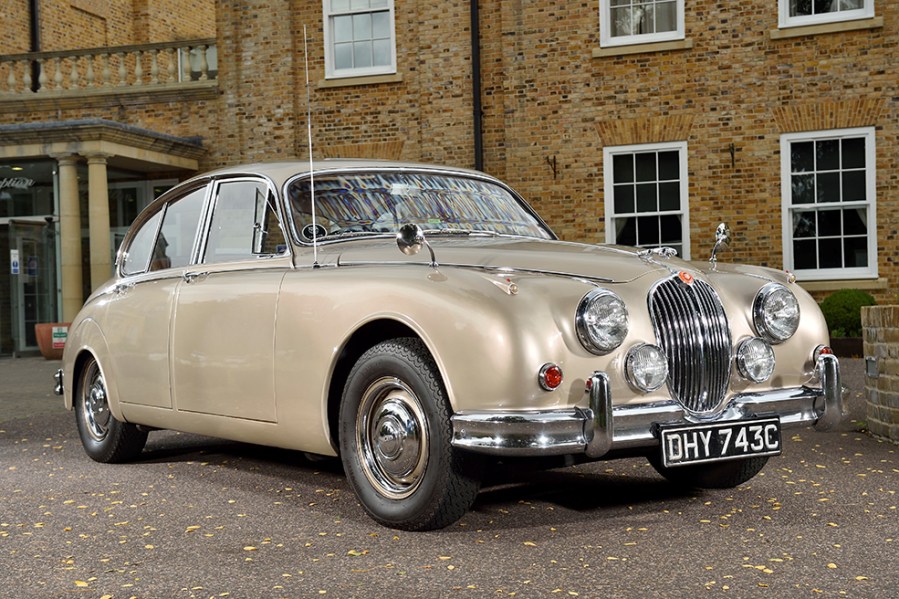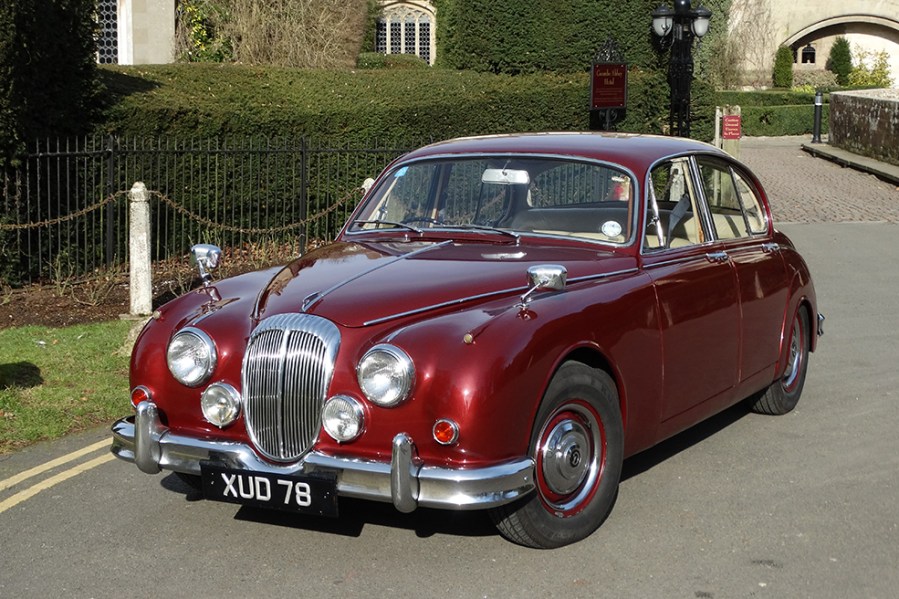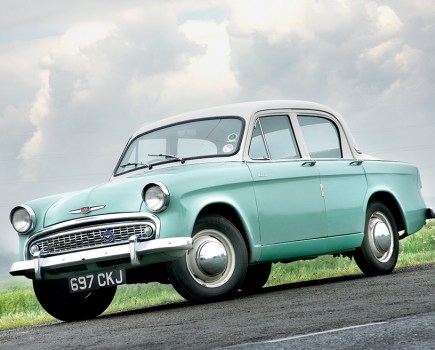Jaguar has a long history of success with its smallest cars through the decades. Here are our favourites
Words: Paul Guinness
Compact sporting saloons with a prestigious badge are nothing new. BMW has made the most of this sector since the 1970s, with different generations of 3 Series models being idolised over the last five decades, and it’s a sector in which other German marques also do well. Interestingly though, compact sporting saloons played an important role in the Jaguar story much earlier, with a succession of different models to boost the company’s sales, appealing to those buyers who craved both practicality and a rewarding driving experience.
The process really got under way with what we now refer to as the ‘Mk1’ (since the arrival of the Mk2 in 1959), although it could be argued that the process began with the Jaguar 1½ Litre of the 1940s and even its SS predecessors. The 1955-on ‘Mk1’ marked the start of a whole new era of Jaguar saloon, however, launching in 1955 badged as the Jaguar 2.4, with the 3.4 being added less than 18 months later. It was a very clever move on the part of Jaguar, for it retained an obvious family link in terms of overall styling, whilst being more modern, more rakish and more low-slung than any previous Jaguar saloon. It didn’t take long for the 2.4 to become the biggest-selling Jaguar of the time, proving to all the world that executive cars didn’t have to be big, cumbersome and old-fashioned.
Despite being an upmarket saloon, the ‘Mk1’ pleased the enthusiastic driver by offering strong performance and decent handling, the latter aided by independent front suspension and standard-fit anti-roll bar. The on-paper figures certainly looked impressive, with even the 2.4 offering a top speed of 101mph – at a time when a three-digit figure was hugely exciting. The 3.4 took this to a whole new level, however, with a maximum speed just shy of 120mph thanks to its uprated version of the six-cylinder ex-XK150 engine, developing 210bhp in this guise (compared with ‘just’ 112bhp from the 2.4 Litre). The 3.4 also looked racier, its open rear wheelarches contrasting with the rear wheel spats of the 2.4.
The ‘Mk1’ proved to be a big hit for Jaguar, attracting well over 37,000 customers worldwide, with almost 20,000 of them opting for the 2.4-litre version. After four years on sale, however, there was a successor waiting in the wings, with Jaguar’s big news of 1959 being the launch of the Mk2.
Jaguar Mk2
Although it carried over many elements of its predecessor’s monocoque bodyshell, the new Mk2 was surprisingly different in overall appearance. The biggest changes were above the waistline, which saw a dramatic increase in glass area; the side windows were deeper, the windscreen was larger and the rear screen was of a wrap-around design. Combined with a redesigned grille and new-look lights, the overall effect was quite dramatic, with the Mk2 having the appearance of a genuinely new car.
Mechanically, meanwhile, there were plenty of familiar features, including continued use of its predecessor’s 2.4- and 3.4-litre straight-six XK powerplants, now complemented by a range-topping 3.8-litre version. Other improvements included the standard fitment of Dunlop disc brakes, as well as a wider track for improved handling. Early cars were offered with either a Borg Warner automatic or Moss four-speed (plus overdrive) manual transmission, though the latter was swapped for a fully-synchromesh Jaguar manual set-up by September 1965.
The Mk2 was, of course, a driver’s car, despite offering all the practicality of a four-door saloon. In his book ‘Jaguar Mk1 & 2 with 240, 340 & Daimler Derivatives’ (Crowood Press, 1995), author James Taylor praises the Mk2 3.8 in particular, hailing its “astonishing acceleration for the time together with a maximum speed way beyond the wildest dreams of the average motorist”. But even the smaller-engined models had plenty to offer, explained Taylor: “Out on the road, the cars could be hustled through corners at a cracking pace, their wider rear tracks giving greater stability than any standard ‘Mk1’ compact ever had.”

Jaguar 240/340
The Mk2 sold strongly throughout much of the 1960s, although the imminent arrival of the XJ6 saw it being killed off by late 1967. Two re-branded versions – the Jaguar 240 and 340 – were launched, however, the most obvious external differences being their use of slimline bumpers for a lighter and arguably more attractive look, while the interior saw Ambla vinyl upholstery as standard fitment (although anyone who craved hide-covered seats simply had to pay a little extra for the privilege).
The 240 had a useful advantage over the old entry-level Mk2, as a revised version of Jaguar’s 2.4-litre XK unit brought an increase in power from 120bhp to 133bhp, achieved via use of a straight-port cylinder head (similar to that used in the 4.2-litre E-Type) in place of the Mk2’s old B-type head, plus twin SU HS6 carburettors (rather than the previous Solex units) and a dual-pipe exhaust system. The end result was an entry-level Jaguar that could exceed 100mph, with much-improved acceleration along the way.
Jaguar also had a marketing trick up its corporate sleeve, launching the 240 with highly competitive pricing that pitched it against models from an array of less prestigious marques. The cheapest (manual) version of the 240 was available for just £1365 at the time of its debut, making it a mere £8 dearer than the Rover 2000. And while the Solihull car had the advantage in terms of freshness and trendiness, its Coventry-built rival offered the extra allure of being a Jaguar, with all the prestige this implied. Both the 240 and 340 were only ever intended as stop-gap designs, however, with the larger-engined car ceasing production as early as 1968, while the 240 lingered on until the following year.
Production figures for the entire Mk2-based line-up make impressive reading, with the 3.8 model being the most successful of all. Out of the 83,980 Mk2s built between 1959 and ’67, a healthy 30,141 were the 3.8 flagship, with the 2.4 and 3.4 models achieving sales of 25,173 and 28,666 respectively. The short-lived 240 and 340 models, meanwhile, attracted 4446 and 2788 buyers respectively.
Jaguar S-type
Coming to market four years after the Mk2 and bearing more than a passing resemblance to its stablemate was the S-type, Jaguar’s latest take on the compact saloon. It was an interesting move, given that the Mk2 was still a popular choice. Jaguar knew, however, that a slightly more upmarket and technically more advanced derivative could be a strong seller, hence the S-type’s independent rear suspension.
Styling-wise the S-type was a fascinating combination of a Mk2-like front end combined with what appeared to be a slightly shrunken MkX rear. It meant a longer boot and a flatter rear roofline, as well as ‘squared-off’ rear wheelarches and thinner bumpers each end. The result was pleasing, with the S-type boasting a more modern, lower stance than the Mk2 on which it was based. It was the ideal vehicle for anyone who craved the advanced suspension design of the MkX within a Mk2-sized package.
Flagship of the S-type range was the inaugural 3.8-litre version, featuring a twin-carb (HD-8 SUs) version of the XK straight-six. The 3.4-litre S-type arrived a few months later, although the difference in power output wasn’t huge, with the 3.4’s 210bhp being just 10bhp behind the 3.8’s figure. Keen drivers inevitably preferred the extra torque of the 3.8, however, with 240lb ft (at 3000rpm) on offer compared with ‘just’ 216lb.ft from the smaller-engined S-Type.
There were obviously differences when it came to performance, with the 3.8 offering a top speed well in excess of 120mph, plus 0-60 in around 10 seconds (in manual/overdrive spec). By comparison the 3.4 knocked around 5mph off the top end, and added a good couple of seconds onto that 0-60 time. Each S-type offered slightly poorer performance than the equivalent Jaguar Mk2, however, thanks to the former’s independent rear suspension adding the best part of 350lb to its kerb weight. The upside was a smoother, more sophisticated ride quality than the Mk2’s, even if the S-type did lose some of its sporting feel.
Although the S-type was announced in September 1963, production wasn’t ramped up until a few months later – which explains why a mere 43 cars were built during that inaugural year. A total of 7032 S-types rolled off the line in 1964, but the following year was the model’s best ever – with 9741 sold worldwide. By the time the very last S-type was produced in 1968, a total of 24,993 cars had found buyers – a respectable but not outstanding result. Indeed, throughout most of its five-year run, the S-type was outsold by the Mk2, despite the latter being the older and less technologically advanced design.
Jaguar 420
An interesting offshoot of the S-type came via the announcement of the new Jaguar 420 (and its Daimler equivalent, the Sovereign) at the Earl’s Court Motor Show in October 1966. Onlookers might have been confused, however, thanks to the 420 being an addition to the line-up rather than a replacement for the existing Mk2 and S-type. Did Jaguar really need yet another compact saloon in its range? With the benefit of hindsight, the decision to launch the 420 was a clever one, enabling Jaguar to offer a new, more powerful model for a couple of years, injecting fresh interest into its line-up whilst the XJ6 was still in development.
The fact that the 420 managed to look substantially different was an equally clever move, with Jaguar boss William Lyons insisting on a new flat-fronted look. Not only was this in complete contrast to the rounded frontal styling that had dominated the company’s compact offerings since the ‘Mk1’, it gave a hint of Jaguar’s new direction for the 1970s.
The 420’s interior was also developed from the S-type’s, albeit now featuring a roll-top to the dashboard and vinyl on the tops of the door trims where there had once been wood. The badge-engineered Daimler Sovereign version (mechanically the same apart from offering overdrive as standard) featured the marque’s traditional fluted radiator grille and a few minor interior changes, taking it over the £2000 price barrier in the UK compared with £1930 for its Jaguar cousin.
Jaguar fitted the 420 and Sovereign with the company’s latest 4235cc twin-carb version of the venerable XK engine, which pushed out 245bhp (at 5500rpm) and 283lb.ft of torque. The end result was a Jaguar saloon with real performance potential, although its handling wasn’t a match for all that power. As author Martin Buckley, in ‘Jaguar: Speed & Style’ (Haynes, 1998) explains, this is still the 420’s biggest drawback: “Understeer is very strong with such a hefty engine up front (although the power steering masks its worst excesses), there is more roll than most press-on drivers would feel comfortable with today, and a combination of thin tyres and lots of torque to the rear wheels means cautious progress on wet roads.”
The 420 remained on sale until 1968, inevitably discontinued in favour of the XJ6, while the Sovereign lasted until the following year. Both models had achieved what Jaguar had intended, however, with their respective production figures of 9801 and 5829 cars helping to prevent a slide in sales whilst Jaguar’s exciting new XJ range was in its final stages of development.

Daimler 2½-litre V8
The 420 wasn’t the only compact Jaguar to spawn a Daimler derivative, although the earlier example – initially badged as the 2½ Litre V8 – represented far more than a badge-engineering exercise. When Jaguar acquired Daimler (from previous owner BSA) in May 1960, it inherited the 2548cc V8 engine that was already powering the SP250 sports car. The desire to offer a compact Daimler led to the coming together of that small V8 and the Jaguar Mk2, with the 2½-litre V8 saloon being unveiled at the 1962 Earl’s Court Motor Show, although it wasn’t until early the following year that production properly got under way.
Jaguar carried out numerous changes to the Daimler V8 engine during development of the saloon, which included redesigning the sump (for an easy fit between the Mk2’s front suspension units), repositioning the water pump, fitting new-design exhaust manifolds and slimming down the main bearings to create enough space to balance the crankshafts. The suspension settings were also altered, with the less weighty V8 engine (saving 51kg over the regular straight-six) inevitably creating a difference in weight distribution.
Of course, there were no problems when it came to power, with the V8 offering an impressive 140bhp at 5800rpm (and a useful 155lb.ft of torque at 3600rpm), aided by twin SU HD6 carburettors. Throw into the mix Borg Warner Type 35 automatic transmission and the end result was a luxurious, immensely comfortable saloon with strong performance and – as you’d expect from a Daimler – an effortless driving style.
The most obvious visual change was to the radiator grille, which followed Daimler tradition via its fluted top, while the bonnet was adorned with a ‘flying D’ mascot. The bootlid sported both ‘Daimler’ and ‘V8’ badging, and was also fitted with a number plate lamp featuring an appropriately fluted chrome surround. The hubcaps (surrounded by handsome Rimbellishers) were given ‘D’ emblems in their centres, while the rear bumper also received the same emblem treatment.
The Daimler 2½-litre V8’s interior benefited from various changes over the standard Jaguar Mk2, including fitment of a split bench seat up front, plus fine-quality hide and plusher wood-veneered trimmings throughout. The dashboard differed slightly from the Mk2’s thanks to a veneered extension below the central part (housing the radio, heater controls and ashtray), while the Jaguar steering wheel was modified via the inevitable use of a ‘D’ central emblem.
This wasn’t a particularly long-lived model, surviving through to 1969 – although from September 1967 it was rebadged as the Daimler V8-250, bringing it more in line with the latest Jaguar branding. Peak year for the V8-engined compact Daimler was 1964, when a total of 3926 examples were produced – just 107 of which were left-hand drive. The 2½-litre and V8-250 were both built predominantly for the home market, which explains why the total number of V8-engined Daimler saloons produced during their seven years on sale was a fairly lowly 17,883 units.
From then on, future Daimler saloons would all be XJ-derived, offering more luxurious fixtures and fittings but no mechanical changes over their Jaguar cousins. And with the XJ6 of 1968-on being substantially larger than the previous family of compacts, its arrival marked the end of a highly successful era for Jaguar.

Jaguar X-Type
Indeed, not until the arrival of the controversial X-Type in 2001 would Jaguar once again tackle the compact saloon sector, which by then was dominated by German models from companies like BMW, Audi and Mercedes-Benz.
With Jaguar having been owned by Ford since the start of the 90s, it found itself with ample funds to develop extra model lines, a process that began when the traditional looking X300 replaced the XJ40 range in 1994, and when the XJS bowed out in favour of the XK8 two years later. But it was the 1998 motor show debut of the S-Type that Jaguar suddenly became a three-model company again, boosted by a fourth model line when the X-Type was unveiled three years later.
The S-Type had successfully broadened the Jaguar range and was a big enough seller to lift volume over the critical 100,000 units per year mark, but Ford wanted further expansion – and the obvious answer was a model to sit in the segment below, aimed at the likes of the BMW 3 Series. This was, however, to prove a harder development task, since the S-Type platform couldn’t be adapted to produce a smaller car. The obvious solution was to use the CD132 platform underpinning the Ford Mondeo.
In the end, the platform was extensively re-engineered by Jaguar. The dimensions of the X-Type may have been similar but the front suspension was entirely revised, while the rear end essentially used the independent set-up from the Mondeo estate. In the Ford this was used to give the estate a flatter load area, but in the X-Type it allowed a rear subframe and differential to be added for rear-wheel drive.
Offering the newcomer as a front-wheel drive saloon would have been a step too far at launch, and so initially so the X-Type came with four-wheel drive as standard. A separate transfer box used a viscous coupling to send drive to the rear wheels, with the car retaining a rear-biased torque split. Engine options included 2.5- and 3.0-litre versions of the Duratec V6, joined by a smaller 2.1-litre V6 in 2002 – which came with front-drive only. Meanwhile, the first four-cylinder Jaguar appeared in 2003 in the shape of the X-Type diesel (using the 128bhp 2.0-litre unit from the Mondeo TDCi and available only in manual front-wheel drive form), while the estate joined the range in 2004. Three years later, the diesel option was up-gunned to a 2.2-litre, 152bhp option that transformed its performance, and with a facelift the X-Type continued to sell in reasonable numbers.
With Ford confidently predicting annual X-Type sales of 100,000, the model’s total production volume of 350,000 over an eight-year career could be seen as a disappointment. However, when looked at in the context of today’s XE (the X-Type’s spiritual successor), that’s a very healthy number. Indeed, production of the XE was ‘paused’ for much of 2022, with Jaguar Land Rover prioritising its more expensive, higher-profit models at a time of component supply issues and semiconductor shortages.
The very last X-Type was produced in December 2009, with the following year seeing the Halewood plant being fitted out for production of the forthcoming Range Rover Evoque. Now though, more than 21 years on from its launch, the X-Type offers arguably the most cost-effective way into modern-classic Jaguar ownership.





